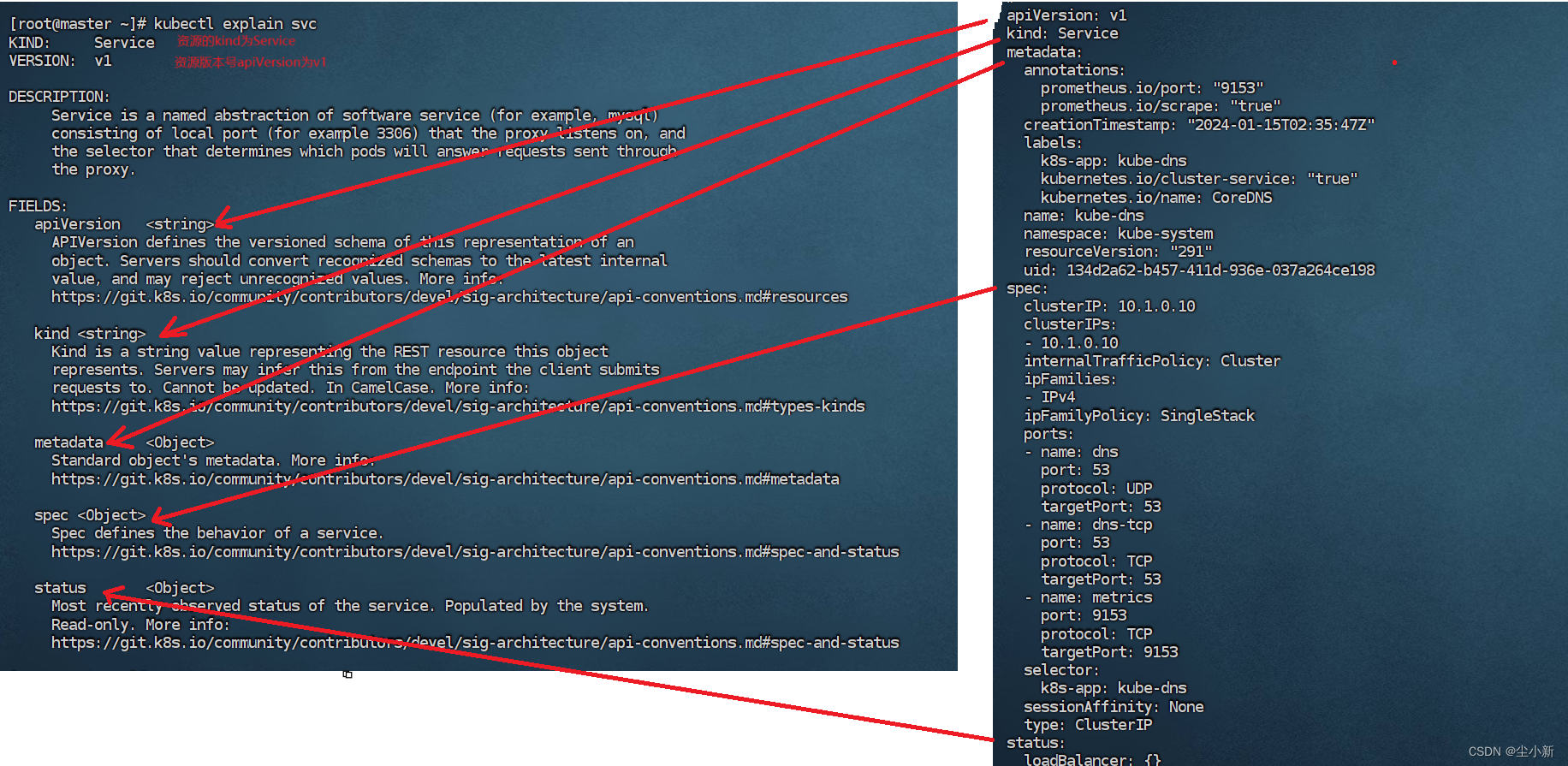
kubectl explain资源文档命令
如何知道当前版本号对应k8s资源的apiVersion
学习并使用了一段时间的kubernetes,发现对k8s还是了解甚少,于是利用上下班通勤的时间又去B站看一些大佬的视频,又来重学巩固一遍知识,并做些记录。
之前在学习使用过程中未成了解过explain这个命令,因为自己部署的版本跟课本内容有差异,有些在文件编写时老师不清楚版本号,走了较多弯路。最近才了解到explian这个命令。因此这里做些记录,后面如果有更深入学习使用会做些补充和更新。
1、explain简介
kubectl explain:资源文档,获取资源及其字段的文档。在定义资源配置文件时,使用该命令可以输出资源对应的属性字段及定义。
可能的资源类型包括:
pods (po), services (svc), replicationcontrollers (rc), nodes (no), events (ev), componentstatuses (cs), limitranges (limits), persistentvolumes (pv), persistentvolumeclaims (pvc), resourcequotas (quota), namespaces (ns), horizontalpodautoscalers (hpa) 或 endpoints (ep)
2、Kubectl语法
kubectl explain RESOURCE
[root@master ~]# kubectl explain --help # 命令帮助文档
List the fields for supported resources.This command describes the fields associated with each supported API resource. Fields are identified via a simple
JSONPath identifier:<type>.<fieldName>[.<fieldName>]
Add the --recursive flag to display all of the fields at once without descriptions. Information about each field is
retrieved from the server in OpenAPI format.Use "kubectl api-resources" for a complete list of supported resources.
Examples:
# Get the documentation of the resource and its fields
kubectl explain pods
# Get the documentation of a specific field of a resource
kubectl explain pods.spec.containersOptions:
--api-version='': Get different explanations for particular API version (API group/version)
--recursive=false: Print the fields of fields (Currently only 1 level deep)Usage:
kubectl explain RESOURCE [options]Use "kubectl options" for a list of global command-line options (applies to all commands).
3、kubectl explain 使用介绍
1)kubectl explain pod 获取pod资源文档
通过这个命令我们可以查看编辑pod yml文档的字段、版本号等信息
[root@master ~]# kubectl explain pod #查看pod资源文档
KIND: Pod # 资源类型
VERSION: v1 # 资源版本号DESCRIPTION:
Pod is a collection of containers that can run on a host. This resource is
created by clients and scheduled onto hosts.FIELDS: #资源文件的字段和字段值类型
apiVersion <string>
APIVersion defines the versioned schema of this representation of an
object. Servers should convert recognized schemas to the latest internal
value, and may reject unrecognized values. More info:
https://git.k8s.io/community/contributors/devel/sig-architecture/api-conventions.md#resourceskind <string>
Kind is a string value representing the REST resource this object
represents. Servers may infer this from the endpoint the client submits
requests to. Cannot be updated. In CamelCase. More info:
https://git.k8s.io/community/contributors/devel/sig-architecture/api-conventions.md#types-kindsmetadata <Object>
Standard object's metadata. More info:
https://git.k8s.io/community/contributors/devel/sig-architecture/api-conventions.md#metadataspec <Object>
Specification of the desired behavior of the pod. More info:
https://git.k8s.io/community/contributors/devel/sig-architecture/api-conventions.md#spec-and-statusstatus <Object>
Most recently observed status of the pod. This data may not be up to date.
Populated by the system. Read-only. More info:
https://git.k8s.io/community/contributors/devel/sig-architecture/api-conventions.md#spec-and-status
2)kubectl explain svc 查看service资源字段的文档
图示对照

3)获取资源的特定字段的文档
kubectl explain pods.spec.containers
我们可以看到每个字段后面都跟着<String>、<Object>之类的释义,说明如下:
| <Object> | 在下一级写数据内容 |
| <String> | 后边填写字符串内容 |
| <[]Object> | (数组对象),需要在下一级开始写内容,下面的第一个内容需要加“-”,作为数据的第一个对象 |
| <Boolean> | 后边填写ture或者false |
| <Integer> | 对应的是整形,后边填写数字 |
| <map[String] string> | go语言的map类型,自定义的键值对(key是字符串,value也是字符串) |
4、kubectl explain选项
1)选项
--recursive[=false]: 打印字段的字段(目前只有1级深)。
2)从父命令继承的选项
| 选项 | 说明 |
| --alsologtostderr[=false] | 记录到标准错误和文件。 |
| --certificate-authority="" | 证书颁发机构的证书文件的路径。 |
| --client-certificate="" | 用于TLS的客户端证书文件的路径。 |
| --client-key="" | 用于TLS的客户端密钥文件的路径。 |
| --cluster="" | 要使用的kubeconfig集群的名称 |
| --context="" | 要使用的kubeconfig上下文的名称 |
| --insecure-skip-tls-verify[=false] | 如果为true,则不会检查服务器证书的有效性。 这将使HTTPS连接不安全。 |
| --kubeconfig="" | 用于CLI请求的kubeconfig文件的路径。 |
| --log-backtrace-at=:0 | 当日志记录达到line file:N时,发出堆栈跟踪 |
| --log-dir="" | 如果非空,则将日志文件写入此目录 |
| --log-flush-frequency=5s | 两次日志刷新之间的最大秒数 |
| --logtostderr[=true] | 日志到标准错误而不是文件 |
| --match-server-version[=false] | 要求服务器版本与客户端版本匹配 |
| --namespace="" | 如果存在,则此CLI请求的名称空间作用域。 |
| --password="" | API服务器基本身份验证密码。 |
| -s, --server="" | Kubernetes API服务器的地址和端口 |
| --stderrthreshold=2 | 达到或超过这个阈值的日志将发送到stderr |
| --token="" | API服务器身份验证的Bearer token。 |
| --user="" | 要使用的kubeconfig用户的名称 |
| --username="" | API服务器基本认证的用户名。 |
| --v=0 | 日志级别为V日志 |
| --vmodule= | 用逗号分隔的pattern=N个 用于文件过滤日志记录的设置列表 |
更多推荐
 已为社区贡献12条内容
已为社区贡献12条内容






所有评论(0)